Chapter: 11th Physics : UNIT 4 : Work, Energy and Power
Energy
ENERGY
Energy is defined as the capacity to
do work. In other
words, work done is the manifestation
of energy. That is why work and energy have the same dimension (ML2T-2)

The
important aspect of energy is that for an isolated system, the sum of all forms
of energy i.e., the total energy remains the same in any process irrespective
of whatever internal changes may take place. This means that the energy
disappearing in one form reappears in another form. This is known as the law of
conservation of energy. In this chapter we shall take up only the mechanical
energy for discussion.
In
a broader sense, mechanical energy is classified into two types
i.
Kinetic
energy
ii.
Potential
energy
The energy possessed by a body due
to its motion is called kinetic energy. The energy possessed by the body by
virtue of its position is called potential energy.
The
SI unit of energy is the same as that of work done i.e., N m (or) joule.
The
dimension of energy is also the same as that of work done. It is given by [ML2T-2].
The other units of energy and their SI equivalent values are given in Table
4.2.
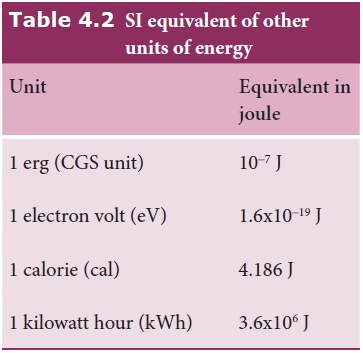
Kinetic
energy
Kinetic energy is the energy
possessed by a body by virtue of its motion. All moving objects
have kinetic energy. A body that is in motion has the ability to do work. For
example a hammer kept at rest on a nail does not push the nail into the wood.
Whereas the same hammer when it strikes the nail, draws the nail into the wood
as shown in Figure 4.7. Kinetic energy is measured by the amount of work that
the body can perform before it comes to rest. The amount of work done by a
moving body depends both on the mass of the body and the magnitude of its
velocity. A body which is not in motion does not have kinetic energy.
Work-Kinetic Energy Theorem
Work
and energy are equivalents. This is true in the case of kinetic energy also. To
prove this, let us consider a body of mass m at rest on a frictionless
horizontal surface.
The
work (W) done by the constant force (F) for a displacement (s) in the same
direction is,

The
constant force is given by the equation,

The
third equation of motion (refer section 2.10.3) can be written as,
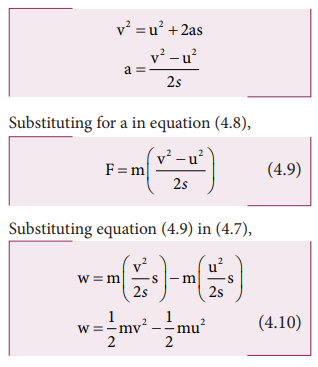
The expression for kinetic energy:
The
term ½ mv2 in the above equation is the kinetic energy of the body
of mass (m) moving with velocity (v).

Kinetic
energy of the body is always positive. From equations (4.10) and (4.11)

The
expression on the right hand side (RHS) of equation (4.12) is the change in
kinetic energy (∆KE) of the body.

This
implies that the work done by the force on the body changes the kinetic energy
of the body. This is called work-kinetic energy theorem.
The work-kinetic energy theorem
implies the following.
i.
If
the work done by the force on the body is positive then its kinetic energy
increases.
ii.
If
the work done by the force on the body is negative then its kinetic energy
decreases.
iii.
If
there is no work done by the force on the body then there is no change in its
kinetic energy, which means that the body has moved at constant speed provided
its mass remains constant.
Relation between Momentum and Kinetic Energy
Consider
an object of mass m moving with a velocity ![]() . Then its linear momentum
is
. Then its linear momentum
is  and its kinetic energy, KE =
½ mv2 .
and its kinetic energy, KE =
½ mv2 .

Multiplying
both the numerator and denominator of equation (4.13) by mass, m

where ![]() is the magnitude of the momentum. The magnitude of the linear
momentum can be obtained by
is the magnitude of the momentum. The magnitude of the linear
momentum can be obtained by

Note that if kinetic energy and mass are given, only the magnitude of the momentum can be calculated but not the direction of momentum. It is because the kinetic energy and mass are scalars.
Potential Energy
The
potential energy of a body is associated with its position and configuration
with respect to its surroundings. This is because the various forces acting on
the body also depends on position and configuration.
“Potential energy of an object at a
point P is defined as the amount of work done by an external force in moving
the object at constant velocity from the point O (initial location) to the
point P (final location). At initial point O potential energy can be taken as
zero.

where
the limit of integration ranges from initial location point O to final location
point P.
We
have various types of potential energies. Each type is associated with a
particular force. For example,
(i)
The energy possessed by the body due to gravitational force gives rise to
gravitational potential energy.
(ii)
The energy due to spring force and other similar forces give rise to elastic
potential energy.
(iii)
The energy due to electrostatic force on charges gives rise to electrostatic
potential energy.
We will learn more about conservative forces in the section 4.2.7. Now, we continue to discuss more about gravitational potential energy and elastic potential energy.
Potential energy near the surface of the Earth
The
gravitational potential energy (U) at some height h is equal to the amount of
work required to take the object from ground to that height h with constant
velocity.
Let
us consider a body of mass m being moved from ground to the height h against
the gravitational force as shown in Figure 4.8.
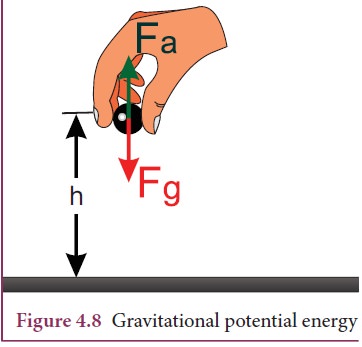
The gravitational force ![]() g acting on the body is,
g acting on the body is, ![]() g = - mg jˆ (as the force is in y direction, unit vector ˆj is used). Here, negative sign implies that the force is acting vertically
downwards. In order to move the body without acceleration (or with constant
velocity), an external applied force
g = - mg jˆ (as the force is in y direction, unit vector ˆj is used). Here, negative sign implies that the force is acting vertically
downwards. In order to move the body without acceleration (or with constant
velocity), an external applied force ![]() a equal in magnitude but opposite to that of gravitational force
a equal in magnitude but opposite to that of gravitational force ![]() g has to be applied on the
body i.e.,
g has to be applied on the
body i.e., ![]() a = -
a = - ![]() g . This implies that
g . This implies that ![]() a = + mg jˆ.
The positive sign implies that the applied force is in vertically upward direction. Hence,
when the body is lifted up its velocity remains unchanged and thus its kinetic
energy also remains constant.
a = + mg jˆ.
The positive sign implies that the applied force is in vertically upward direction. Hence,
when the body is lifted up its velocity remains unchanged and thus its kinetic
energy also remains constant.
The
gravitational potential energy (U) at some height h is equal to the amount of work required to take the object from
the ground to that height h.

Since
the displacement and the applied force are in the same upward direction, the
angle between them, θ=0o. Hence, cos00 =1 and |![]() a| = mg and |d
a| = mg and |d![]() | = dr .
| = dr .
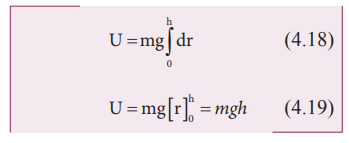
Note
that the potential energy stored in the object is defined through work done by
the external force which is positive. Physically this implies that the agency
which is applying the external force is transferring the energy to the object
which is then stored as potential energy. If the object is allowed to fall from
a height h then the stored potential
energy is converted into kinetic energy.
Elastic Potential Energy
When
a spring is elongated, it develops a restoring force. The potential energy possessed by
a spring due to a deforming force which stretches or compresses the spring is
termed as elastic potential energy. The work done by the applied force against the restoring force of the spring is
stored as the elastic potential energy in the spring.
Consider
a spring-mass system. Let us assume a mass, m
lying on a smooth horizontal table as shown in Figure 4.9. Here, x = 0 is the equilibrium position. One
end of the spring is attached to a rigid wall and the other end to the mass.

As
long as the spring remains in equilibrium position, its potential energy is
zero. Now an external force ![]() a is applied so that it is stretched by a distance (x) in the direction of the force.
a is applied so that it is stretched by a distance (x) in the direction of the force.
There
is a restoring force called spring force ![]() s developed in the spring which tries to bring the
mass back to its original position. This applied force and the spring force are
equal in magnitude but opposite in direction i.e.,
s developed in the spring which tries to bring the
mass back to its original position. This applied force and the spring force are
equal in magnitude but opposite in direction i.e., ![]() a
=-
a
=-![]() s . According Hooke’s law, the restoring force developed in the
spring is
s . According Hooke’s law, the restoring force developed in the
spring is

The
negative sign in the above expression implies that the spring force is always
opposite to that of displacement ![]() and k is the force constant.
Therefore applied force is
and k is the force constant.
Therefore applied force is ![]() a = + k
a = + k ![]() . The positive sign implies that the
applied force is in the direction of displacement
. The positive sign implies that the
applied force is in the direction of displacement ![]() . The spring force is an example of
variable force as it depends on the displacement
. The spring force is an example of
variable force as it depends on the displacement ![]() . Let the spring be stretched to a
small distance d
. Let the spring be stretched to a
small distance d![]() .
The work done by the applied force on the spring to stretch it by a
displacement
.
The work done by the applied force on the spring to stretch it by a
displacement ![]() is
stored as elastic potential energy.
is
stored as elastic potential energy.

The
applied force ![]() a and the displacement d
a and the displacement d![]() (i.e.,
here dx ) are in the same direction.
As, the initial position is taken as the equilibrium position or mean position,
x=0 is the lower limit of
integration.
(i.e.,
here dx ) are in the same direction.
As, the initial position is taken as the equilibrium position or mean position,
x=0 is the lower limit of
integration.
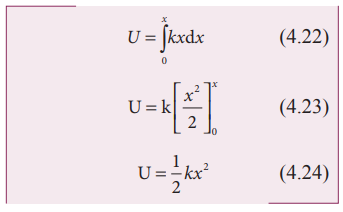
If
the initial position is not zero, and if the mass is changed from position xi to xf , then the elastic potential energy is

From
equations (4.24) and (4.25), we observe that the potential energy of the
stretched spring depends on the force constant k and elongation or compression x.
Force-displacement graph for a spring
Since
the restoring spring force and displacement are linearly related as F = - k x, and are opposite in
direction, the graph between F and x is a straight line with dwelling only
in the second and fourth quadrant as shown in Figure 4.10. The elastic
potential energy can be easily calculated by drawing a F - x graph. The shaded area (triangle) is the work done by the spring
force.
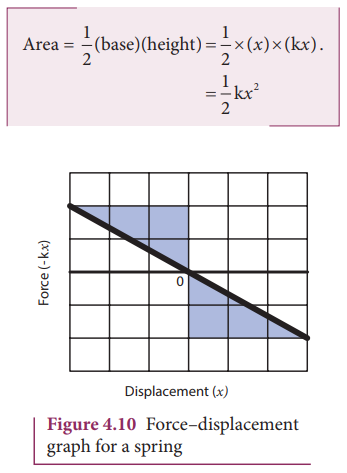
Potential energy-displacement graph
for a spring
A
compressed or extended spring will transfer its stored potential energy into
kinetic energy of the mass attached to the spring. The potential
energy-displacement graph is shown in Figure 4.11.
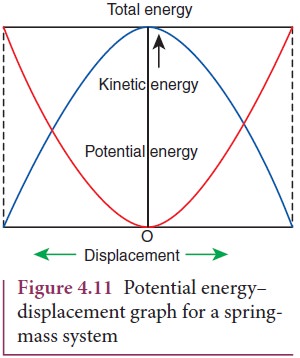
In
a frictionless environment, the energy gets transferred from kinetic to
potential and potential to kinetic repeatedly such that the total energy of the
system remains constant. At the mean position,

The
work done on the springs are stored as potential energy in the springs.
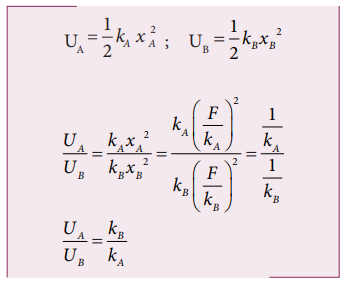
kA>kB
implies that UB>UA . Thus, more work is done on B than
A.
Conservative and non- conservative forces
Conservative force
A
force is said to be a conservative force if the work done by or against the
force in moving the body depends only on the initial and final positions of the
body and not on the nature of the path followed between the initial and final
positions.
Let
us consider an object at point A on the Earth. It can be taken to another point
B at a height h above the surface of
the Earth by three paths as shown in Figure 4.12.
Whatever
may be the path, the work done against the gravitational force is the same as
long as the initial and final positions are the same. This is the reason why
gravitational force is a conservative force. Conservative force is equal to the
negative gradient of the potential energy. In one dimensional case,
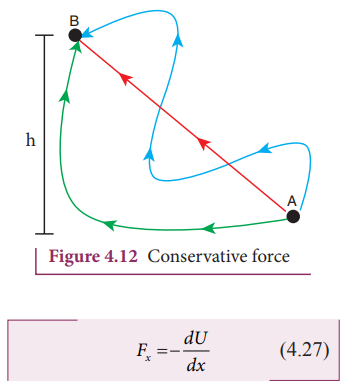
Examples for conservative forces are elastic spring force, electrostatic force, magnetic force, gravitational force, etc.
Non-conservative force
A
force is said to be non-conservative if the work done by or against the force
in moving a body depends upon the path between the initial and final positions.
This means that the value of work done is different in different paths.
1.
Frictional forces are non-conservative forces as the work done against friction
depends on the length of the path moved by the body.
2.
The force due to air resistance, viscous force are also non-conservative forces
as the work done by or against these forces depends upon the velocity of
motion.
The
properties of conservative and non-conservative forces are summarized in the
Table 4.3.

Law of conservation of energy
When
an object is thrown upwards its kinetic energy goes on decreasing and
consequently its potential energy keeps increasing (neglecting air resistance).
When it reaches the highest point its energy is completely potential.
Similarly, when the object falls back from a height its kinetic energy
increases whereas its potential energy decreases. When it touches the ground
its energy is completely kinetic. At the intermediate points the energy is both
kinetic and potential as shown in Figure 4.13. When the body reaches the ground
the kinetic energy is completely dissipated into some other form of energy like
sound, heat, light and deformation of the body etc.
In
this example the energy transformation takes place at every point. The sum of
kinetic energy and potential energy i.e., the total mechanical energy always
remains constant, implying that the total energy is conserved. This is stated
as the law of conservation of energy.
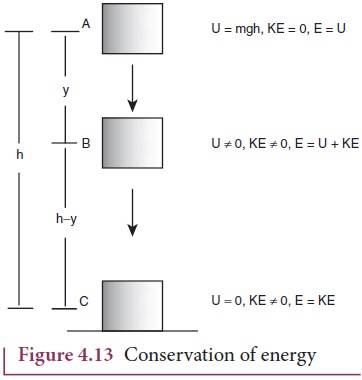
The
law of conservation of energy states that energy
can neither be created nor destroyed.
It may be transformed from one form to another but the total energy of an
isolated system remains constant.
Figure 4.13 illustrates that, if an object starts from rest at height h, the total energy is purely potential energy (U=mgh) and the kinetic energy (KE) is zero at h. When the object falls at some distance y, the potential energy and the kinetic energy are not zero whereas, the total energy remains same as measured at height h. When the object is about to touch the ground, the potential energy is zero and total energy is purely kinetic.
Motion in a vertical circle
Imagine
that a body of mass (m) attached to one end of a massless and inextensible
string executes circular motion in a vertical plane with the other end of the
string fixed. The length of the string becomes the radius ( ![]() ) of the circular path (Figure 4.14).
) of the circular path (Figure 4.14).
Let
us discuss the motion of the body by taking the free body diagram (FBD) at
position where the position vector ( ![]() ) makes an angle θ with the vertically downward direction and the
instantaneous velocity is as shown in Figure 4.14.
) makes an angle θ with the vertically downward direction and the
instantaneous velocity is as shown in Figure 4.14.
There
are two forces acting on the mass.
1.
Gravitational
force which acts downward
2.
Tension
along the string.
Applying
Newton’s second law on the mass, In the tangential direction,

The
circle can be divided into four sections A, B, C, D for better understanding of
the motion. The four important facts to be understood from the two equations
are as follows:
i.
The mass is having tangential acceleration (g sin θ) for all values of θ
(except θ = 0o), it is clear that this vertical cirular motion is
not a uniform circular motion.
ii.
From the equations (4.28) and (4.29) it is understood that as the magnitude of
velocity is not a constant in the course of motion, the tension in the string
is also not constant.
iii. The equation T = mg cosθ + mv2/r highlights that in sections A and D
of the circle, (for –π/2 < θ < π/2;cosθ is positive) , the term mg cosθ is always
greater than zero. Hence the tension cannot vanish even when the velocity
vanishes.
iv.
The equation mv2/r = T - mg cosθ further highlights that in sections B and D of the circle, (for –π/2 < θ < 3π/2;cosθ is negative) the second term is always greater than zero. Hence velocity
cannot vanish, even when the tension vanishes.
These
points are to be kept in mind while solving problems related to motion in
vertical circle.
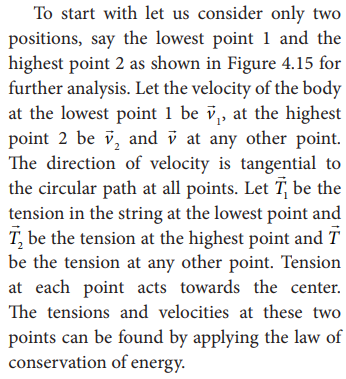
For the lowest point (1)
When
the body is at the lowest point 1, the gravitational force m ![]() which acts on the body (vertically downwards) and
another one is the tension
which acts on the body (vertically downwards) and
another one is the tension ![]() 1 acting vertically upwards, i.e. towards the center. From the
equation (4.29), we get
1 acting vertically upwards, i.e. towards the center. From the
equation (4.29), we get
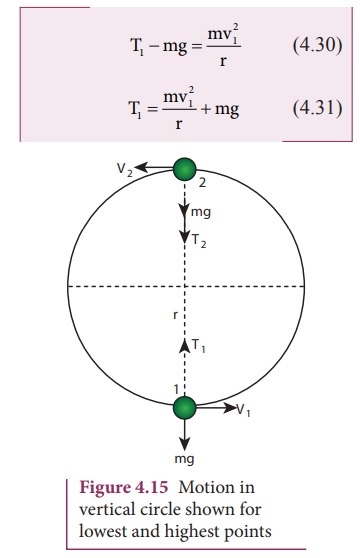
For the highest point (2)
At
the highest point 2, both the gravitational force m![]() on the body and the tension
on the body and the tension ![]() 2 act downwards, i.e.
towards the center again.
2 act downwards, i.e.
towards the center again.
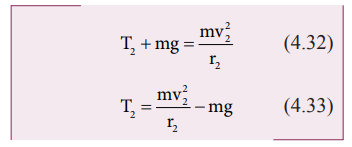
From
equations (4.31) and (4.33), it is understood that T1 > T2. The difference in tension T1 - T2 is obtained by subtracting equation (4.33)
from equation (4.31).
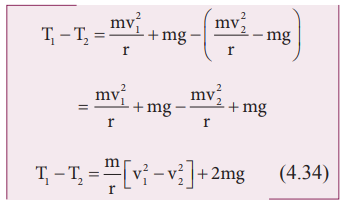
The
term [v12 – v22] can be found
easily by applying law of conservation of energy at point 1 and also at point
2.
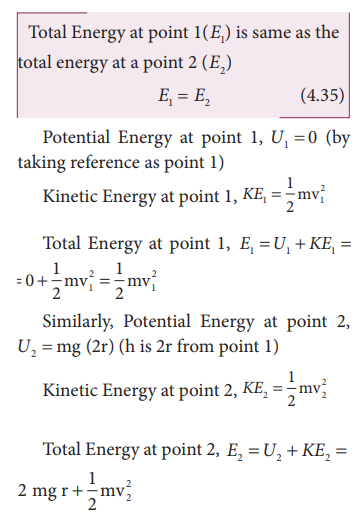
From
the law of conservation of energy given in equation (4.35), we get

Minimum speed at the highest point (2)
The
body must have a minimum speed at point 2 otherwise, the string will slack
before reaching point 2 and the body will not loop the circle. To find this
minimum speed let us take the tension T2 = 0 in equation (4.33).

The body must have a speed at point 2, v2 ≥ √gr to stay in the circular path.
Minimum speed at the lowest point 1
To
have this minimum speed (v2=√gr)
at point 2, the body must have minimum speed also at point 1.
By
making use of equation (4.36) we can find the minimum speed at point 1.

The
body must have a speed at point 1, v1≥√5gr to stay in the circular
path.
From
equations (4.38) and (4.39), it is clear that the minimum speed at the lowest
point 1 should be √5 times more than the minimum speed at the highest point 2,
so that the body loops without leaving the circle.
Solved Example Problems for Kinetic energy
Example 4.7
Two objects of masses 2 kg and 4 kg are moving with the same momentum of 20 kg m s-1.
a. Will they have same kinetic energy?
b. Will they have same speed?
Solution
a. The kinetic energy of the mass is given by
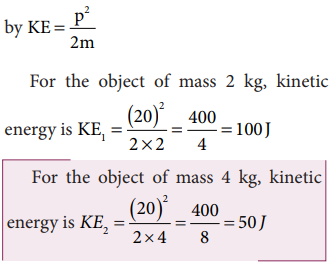
Note that KE1 ≠ KE2 i.e., even though both are having the same momentum, the kinetic energy of both masses is not the same. The kinetic energy of the heavier object has lesser kinetic energy than smaller mass. It is because the kinetic energy is inversely proportional to the mass (KE ∝ 1/m) for a given momentum.
b. As the momentum, p = mv, the two objects will not have same speed.
Solved Example Problems for Potential Energy
Example 4.8
An object of mass 2 kg is taken to a height 5 m from the ground g = 10ms-2 .
a. Calculate the potential energy stored in the object.
b. Where does this potential energy come from?
c. What external force must act to bring the mass to that height?
d. What is the net force that acts on the object while the object is taken to the height ‘h’?
Solution
a. The potential energy U =m g h = 2 × 10 × 5 = 100 J
Here the positive sign implies that the energy is stored on the mass.
b. This potential energy is transferred from external agency which applies the force on the mass.
c.
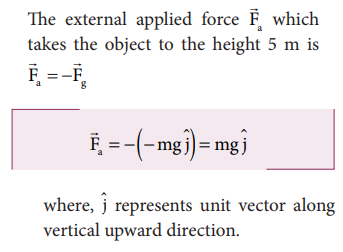
d. From the definition of potential energy, the object must be moved at constant velocity. So the net force acting on the object is zero.

Solved Example Problems for Elastic Potential Energy
Example 4.9
Let the two springs A and B be such that kA>kB. On which spring will more work has to be done if they are stretched by the same force?
Solution
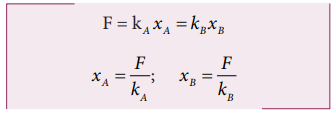
The work done on the springs are stored as potential energy in the springs.
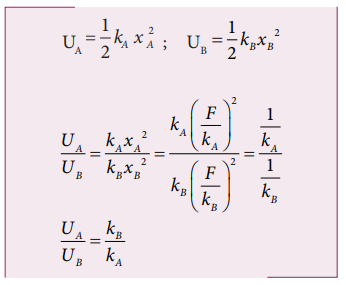
kA>kB implies that UB>UA . Thus, more work is done on B than A.
Example 4.10
A body of mass m is attached to the spring which is elongated to 25 cm by an applied force from its equilibrium position.
a. Calculate the potential energy stored in the spring-mass system?
b. What is the work done by the spring force in this elongation?
c. Suppose the spring is compressed to the same 25 cm, calculate the potential energy stored and also the work done by the spring force during compression. (The spring constant, k = 0.1 N m-1).
Solution
The spring constant, k = 0.1 N m-1
The displacement, x = 25 cm = 0.25 m
a. The potential energy stored in the spring is given by
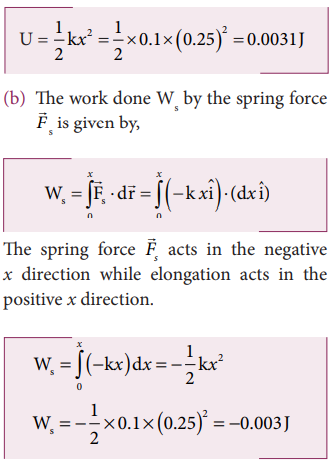
Note that the potential energy is defined through the work done by the external agency. The positive sign in the potential energy implies that the energy is transferred from the agency to the object. But the work done by the restoring force in this case is negative since restoring force is in the opposite direction to the displacement direction.
c. During compression also the potential energy stored in the object is the same.

Work done by the restoring spring force during compression is given by

In the case of compression, the restoring spring force acts towards positive x-axis and displacement is along negative x direction.

Solved Example Problems for Conservative and nonconservative forces
Example 4.11
Compute the work done by the gravitational force for the following cases
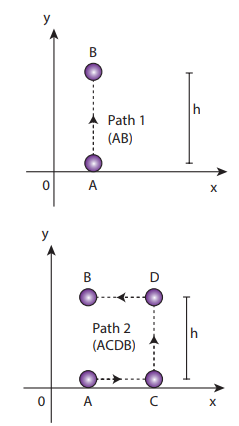
Solution

(As the displacement is in two dimension; unit vectors and are used)
a. Since the motion is only vertical, horizontal displacement component dx is zero. Hence, work done by the force along path 1 (of distance h).
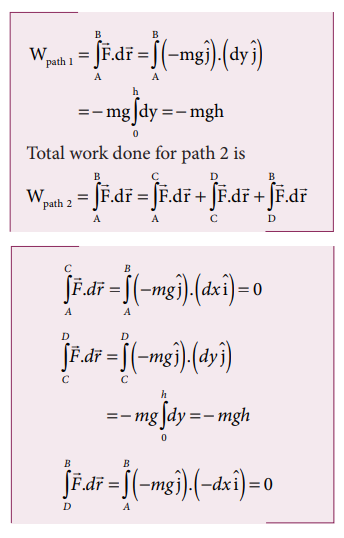
Therefore, the total work done by the force along the path 2 is

Note that the work done by the conservative force is independent of the path.
Example 4.12
Consider an object of mass 2 kg moved by an external force 20 N in a surface having coefficient of kinetic friction 0.9 to a distance 10 m. What is the work done by the external force and kinetic friction ? Comment on the result. (Assume g = 10 ms-2)
Solution
m = 2 kg, d = 10 m, Fext = 20 N, k = 0.9. When an object is in motion on the horizontal surface, it experiences two forces.
a. External force, Fext = 20 N
b. Kinetic friction,
fk =μkmg = 0.9x(2)x10=18N.
The work done by the external force Wext = Fs = 20x20 =200J
The work done by the force of kinetic friction Wk =fkd = (-18) x10=-180J Here the negative sign implies that the force of kinetic friction is pposite to the direction of displacement.
The total work done on the object
Wtotal = Wext + Wk = 200 J – 180 J = 20 J .
Since the friction is a non-conservative force, out of 200 J given by the external force, the 180 J is lost and it can not be recovered.
Solved Example Problems for Law of conservation of energy
Example 4.13
An object of mass 1 kg is falling from the height h = 10 m. Calculate
a. The total energy of an object at h =10 m
b. Potential energy of the object when it is at h = 4 m
c. Kinetic energy of the object when it is at h = 4 m
d. What will be the speed of the object when it hits the ground?
(Assume g =10 m s-2)
Solution
a. The gravitational force is a conservative force. So the total energy remains constant throughout the motion. At h =10 m, the total energyE is entirely potential energy.

b. The potential energy of the object at h = 4 m is

c. Since the total energy is constant throughout the motion, the kinetic energy at h = 4 m must be KE = E - U = 100 - 40 = 60J
Alternatively, the kinetic energy could also be found from velocity of the object at 4 m. At the height 4 m, the object has fallen through a height of 6 m.
The velocity after falling 6 m is calculated from the equation of motion,

d. When the object is just about to hit the ground, the total energy is completely kinetic and the potential energy, U = 0.
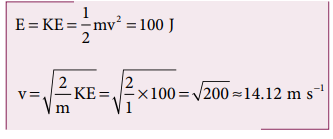
Example 4.14
A body of mass 100 kg is lifted to a height 10 m from the ground in two different ways as shown in the figure. What is the work done by the gravity in both the cases? Why is it easier to take the object through a ramp?
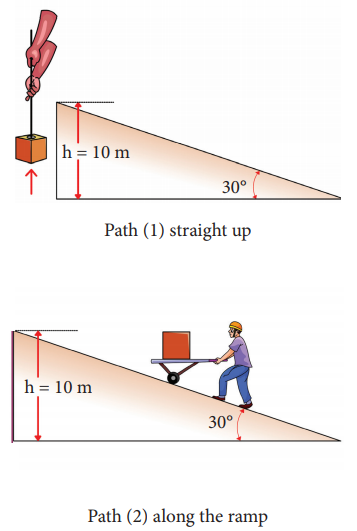
Solution
m = 100 kg, h = 10 m
Along path (1):
The minimum force F1 required to move the object to the height of 10 m should be equal to the gravitational force, F1 mg = 100 x 10 = 1000 N
The distance moved along path (1) is, =10 m
The work done on the object along path (1) is
W = Fh = 1000 x 10 = 10,000 J
Along path (2):
In the case of the ramp, the minimum force F2 that we apply on the object to take it up is not equal to mg, it is rather equal to mg sinθ .(mg sin < mg) .
Here, angle θ = 30o
Therefore, F2 = mg sinθ = 100 × 10 × sin30o = 100 × 10 × 0.5 = 500N
Hence, (mg sinθ < mg)
The path covered along the ramp is,
l = h/sin30 = 10/0.5 =20m
The work done on the object along path (2) is, W = F2 l = 500 × 20 = 10,000 J
Since the gravitational force is a conservative force, the work done by gravity on the object is independent of the path taken.
In both the paths the work done by the gravitational force is 10,000 J
Along path (1): more force needs to be applied against gravity to cover lesser distance .
Along path (2): lesser force needs to be applied against the gravity to cover more distance.
As the force needs to be applied along the ramp is less, it is easier to move the object along the ramp.
Example 4.15
An object of mass m is projected from the ground with initial speed v0.
Find the speed at height h.
Solution
Since the gravitational force is conservative; the total energy is conserved throughout the motion.
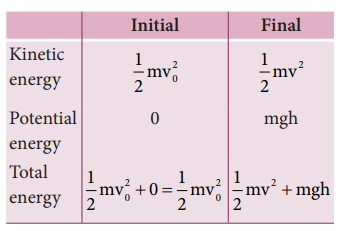
Final values of potential energy, kinetic energy and total energy are measured at the height h.
By law of conservation of energy, the initial and final total energies are the same.
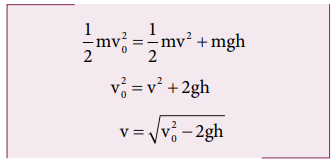
Note that in section (2.11.2) similar result is obtained using kinematic equation based on calculus method. However, calculation through energy conservation method is much easier than calculus method.
Example 4.16
An object of mass 2 kg attached to a spring is moved to a distance x =10 m from its equilibrium position. The spring constant k =1 N m-1and assume that the surface is frictionless.
a. When the mass crosses the equilibrium position, what is the speed of the mass?
b. What is the force that acts on the object when the mass crosses the equilibrium position and extremum position x = ± 10 m.
Solution
a. Since the spring force is a conservative force, the total energy is constant. At x =10 m, the total energy is purely potential.

When the mass crosses the equilibrium position x = 0 , the potential energy

The entire energy is purely kinetic energy at this position.
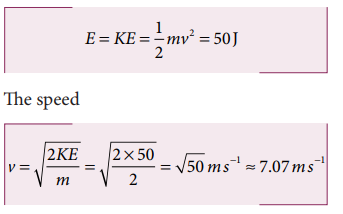
b. Since the restoring spring force is F = - kx, when the object crosses the equilibrium position, it experiences no force. Note that at equilibrium position, the object moves very fast. When the object is at x = +10 m (elongation), the force F = - k x
F = - (1) (10) = - 10 N. Here the negative sign implies that the force is towards equilibrium i.e., towards negative x-axis and when the object is at x = - 10 (compression), it experiences a forces F = - (1) (- 10) = +10 N. Here the positive sign implies that the force points towards positive x-axis.
The object comes to momentary rest at x = ±10m even though it experiences a maximum force at both these points.
Solved Example Problems for Motion in a vertical circle
Example 4.17
Water in a bucket tied with rope is whirled around in a vertical circle of radius 0.5 m. Calculate the minimum velocity at the lowest point so that the water does not spill from it in the course of motion. (g = 10 ms-2)
Solution
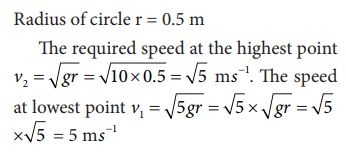
Related Topics